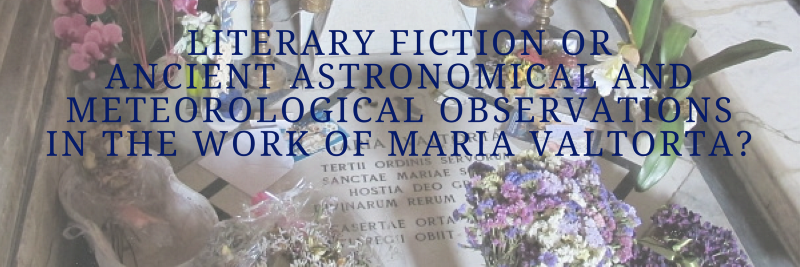
If you want to download the above article as a PDF, click here.
In the peer-reviewed scientific journal Scienze e Ricerche (Science and Research), Professor Emilio Matricciani of the Department of Electronics, Information, and Bioengineering (DEIB) at the Polytechnic of Milan, and Dr. Liberato De Caro of the Institute of Crystallography, National Research Council (IC-CNR), Bari Polytechnic, co-authored an article entitled “Finzione letteraria o antiche osservazioni astronomiche e meteorologiche nell’opera di Maria Valtorta?” (“Literary fiction or ancient astronomical and meteorological observations in the work of Maria Valtorta?”). Here is the abstract from the article:1
The Gospel As Revealed to Me (L’Evangelo come mi è stato rivelato) is the main literary work by Maria Valtorta (1897-1961), written while she was bedridden for serious health problems in the years between the end of World War II and the first years after the war. In her voluminous work she reports detailed descriptions of uses, customs, landscape of Palestine at the time of Jesus of Nazareth, a large quantity of information of every kind: historical, archaeological, astronomical, geographical, meteorological. The richness of narrative elements has allowed pursuing many studies on her literary work because she states that it is not due to her imagination, but that she has written down everything she watched “in vision”. This should not be possible based only on logical reasoning because, as far as we know, it is not possible to have visions on past events which, in this case, would refer to 2000 years ago when Jesus walked the roads of Palestine. However, by a detailed analysis of explicit and implicit calendar information, such as reference to lunar phases, constellations, planets visible in the night sky while she tells what is happening, verifiable with the Astronomy, it is ascertained that every event described implies a precise chronological reference – day, month, year – without being explicitly reported. For example, from this analysis it is inferred that the crucifixion should have occurred on Friday 23rd of April in the year 34, which coincides with one of the dates of crucifixion deducible with the help of Astronomy. Maria Valtorta has recorded also the days with rain and this allows a statistical test with the current meteorological data of Palestine, under the hypothesis of random observations and no important changes regarding rainfall daily frequency in Palestine. The annual or monthly average frequencies of rainy days deduced from the data available from the Israel Meteorological Service and the similar frequencies deduced from the analysis of the Maria Valtorta’s work agree very well. These results are surprising and unexpected, and no scientific explanation seems to be immediate.
The above article by Professor Emilio Matricciani and Dr. Liberato De Caro has also been translated into English and published in the peer-reviewed journal Religions by Swiss publisher MDPI on June 9, 2017. You can view this article in HTML format here and download it in PDF format here.1. Finzione letteraria o antiche osservazioni astronomiche e meteorologiche nell’opera di Maria Valtorta? By Professor Emilio Matricciani and Dr. Liberato De Caro. Scienze e Ricerche. n. 44, January 2017. p. 6. This journal is available online here:
http://www.scienze-ricerche.it/?page_id=7840
An English translation of this article was published in the peer-reviewed journal Religions by Swiss publisher MDPI on June 9, 2017, and is available online in HTML and PDF formats here:
http://www.mdpi.com/2077-1444/8/6/110/htm
http://www.mdpi.com/2077-1444/8/6/110/pdf




